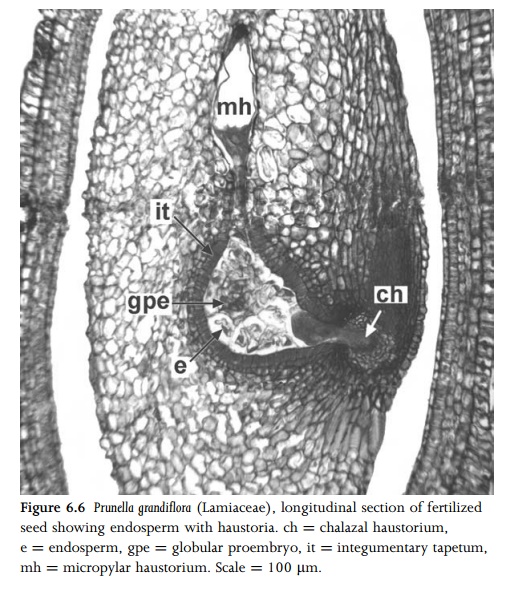Chapter: Anatomy of Flowering Plants: An Introduction to Structure and Development : Seed and fruit
Endosperm
Endosperm
Endosperm forms a food-storage tissue in the seed. It not only promotes
growth and longevity for the seed, but can also facilitate dispersal, as an
attractant to animals. Mature endosperm typically consists of tightly-packed
cells that contain food-reserve materials such as starch grains or protein
bodies. Endosperm is typically a triploid tissue formed by fusion of one sperm
cell with two female polar nuclei. It is present in most angiosperm seeds but
in greatly contrasting amounts; for example, endosperm formation is negligible
in orchid seeds but extensive in grass seeds, in which it forms an important
economic crop.
Early
endosperm development is traditionally classified into three types, termed
nuclear, cellular and helobial, based on the timing and degree of cell wall
formation, though transitional forms exist117. Nuclear endosperm is
the most common type,and occurs in many eudicots (e.g. Arabidopsis thaliana).
Nuclearcell wall formation, and the nuclei are initially free in the cytoplasm
of the embryo sac, usually surrounding a central vacuole. Cell walls eventually
form in most endosperm tissues, but sometimes the nuclei at the chalazal end
remain free; for example, the liquid ‘‘milk’’ of the coconut palm (Cocos
nucifera) is a syncy-tium that contains many free endosperm nuclei in addition
to oil droplets and protein granules.
In the
cellular type of endosperm formation, which occurs in some eudicots (e.g.
Acanthaceae), even the earliest nuclear divisions are followed by cell-wall
formation. In the helobial endosperm type, which is restricted to some
monocots, the primary endosperm nucleus undergoes division to form two unequal
chambers, normally a small chalazal chamber and a large micropylar chamber. The
nucleus of the micropylar chamber migrates to the top of the embryo sac, and
its initial divisions are not accompanied by cell wall formation, though cell
walls are formed with later mitoses. The chalazal chamber has far fewer nuclear
divisions, and its nuclei remain free in the cytoplasm; it typically has a
haustorial role.
Endosperm
haustoria may develop in all three types of endo-sperm. Haustoria assist
nutrient absorption and sometimes invade adjacent tissues. For example, most
species of the mint family Lamiaceae possess both chalazal and micropylar haustoria (Fig. 6.6), which may be either
free-nucleate or cellular, some-times even amoeboid. In these species, the
first division of the primary endosperm nucleus is longitudinal, followed by
formation of a transverse wall. The chalazal nucleus forms a small chalazal
haustorium close to the antipodals, and the micropylar nucleus divides further
to form a micropylar haustorium and a central cellular endosperm. The
micropylar haustorium transfers nutrients from the integument to the embryo and
cellular endosperm.

The
chalazal haustorium transfers nutrients from the vascular bundle to the
endosperm.
Related Topics